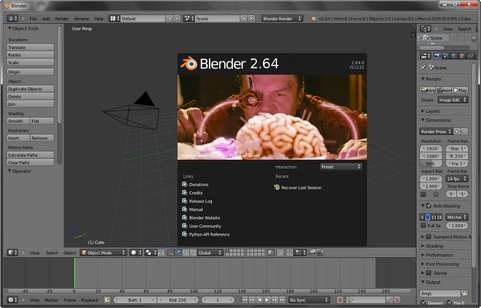
Versie 2.64 van het opensource- en crossplatform-3d-programma Blender is uitgekomen. Deze applicatie is bedoeld voor 3d-modeling, animatie, rendering, post-production, interactive creation en playback. Meer informatie over de uitgebreide mogelijkheden van Blender kunnen op deze pagina worden gevonden. Met dit programma zijn onder meer de opensource-animatiefilms Elephants Dream, Big Buck Bunny, Sintel en de recent verschenen Tears of Steel gemaakt.
De focus lag bij deze release op het creëren van een volledige VFX-pipeline, met verbeterde motion tracking met behulp van een planaire tracker, makkelijker groen-scherm-keying, en een nieuwe masker-editor. Een nieuw op tegels gebaseerd compositingsysteem werd toegevoegd, samen met een meer geavanceerd kleurbeheer. Cycles rendering kreeg tientallen kleinere functies en verbeteringen, die voortvloeien uit het gebruik ervan in een productieomgeving.
Sculpting ondersteunt nu maskers en een huid-modifier werd toegevoegd om in een handomdraai een model te creëren uit skeletten. De game-engine heeft verbeterde schaduwen en natuurkundeopties, en Collada export heeft nu meer mogelijkheden voor de finetuning van het exporteren naar andere game-engines. Het volledige changelog van deze uitgave ziet er als volgt uit:
Mask EditorMasks can now be created in the image and movie clip editor. They can be used in compositing to define areas of influence for nodes or block out unwanted objects. A mask datablock was added, consisting of splines that can be drawn and edited with the usual tools. Feathering can be controlled per spline point. Animation of these masks is possible with standard keyframing and following motion tracks.
Motion TrackerMotion tracking was significantly improved by adding planar tracking, and unifying the existing trackers into one Hybrid tracker with finer control. A dopesheet view for markers was added in addition to the curves view. Tripod solving is now supported, for the case where the camera only rotates without moving.
Green ScreenTwo new compositing nodes have been developed which are aimed at making green screen keying easier. There is now a new keying node conveniently combining various features from existing nodes along with a new keying algorithm, to makes setup much faster. There is also a keying screen node which produces a gradiented plate to deal with uneven colors of green screens.
Mesh ToolsBevel and inset now are modal operator with mouse control, a wire frame tool was added to turn edges into wireframe tubes, and vertex/edge/face sorting tools were improved.
SculptingSculpting has received some major improvements such has masking to control which areas of the mesh are influenced by sculpting, new brush map modes to control how textures are projected onto the model, and an input stroke averaging option to make brush strokes smoother.
Skin ModifierThe Skin modifier takes a skeleton made up of vertices and edges as input and generates a polygon skin as output, consisting mostly of quads aligned along the edges. The output is mostly quads, although some triangles will appear around intersections.
Game EngineLamps and shadows were improved with support for variance shadow maps, shadow color, sun lamp shadows and lamp textures. Non-power of two textures and compressed textures will now load faster and use less memory. A new Character physics type was added, designed for player controlled characters.
CompositingA completely new compositing nodes backend was implemented. This new tiled based compositor gives quicker feedback while editing and uses less memory to support working with high resolutions. New nodes were added for bokeh blur, masks and color correction.
ColorOpenColorIO is now integrated into Blender, along with a redesign of the color management system. Now many more color spaces are supported with finer control over which color transformations should be used for display, applied on renders, and used for loading and saving image files.
Cycles RenderCycles now includes a new non-progressive integrator, tiled rendering with support for save buffers, considerably faster BVH building and multithreaded image loading, and motion vector and UV render passes. New nodes are light falloff, object info, particle info and brick texture, and image texture nodes with blended box mapping and image sequences. There is also support for fisheye camera rendering.
SequencerVarious speed improvements were implemented in the sequencer, for caching and multithreading of effect strips, to make color grading more interactive. Improved options for comparing the current frame to a reference frame are also available.
ColladaThe Collada exporter has been improved for better support of export to game engines, with more fine grained options to control which data is exported.
More FeaturesApart from the major improvements in different areas, there were lots of smaller changes such as improvements in the node editor, smoke simulation, user interface, and new tools for curves and meshes.
Bug fixesLots of new features were added in this release, but it also includes lots of fixes for bugs that existed in previous releases.

Blender 2.64 screenshot, klik op de afbeelding voor een grotere versie.

:fill(white):strip_exif()/i/2000781348.jpeg?f=thumbmedium)